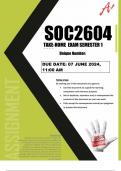SOC2604
TAKE-HOME EXAM SEMESTER 1
2024
Unique Number:
DUE DATE: 07 JUNE 2024,
11:00 AM
Terms of use
By making use of this document you agree to:
Use this document as a guide for learning,
comparison and reference purpose,
Not to duplicate, reproduce and/or misrepresent the
contents of this document as your own work,
Fully accept the consequences should you plagiarise
or misuse this document.
Disclaimer
Extreme care has been used to create this
document, however the contents are provided “as
is” without any representations or warranties,
express or implied. The author assumes no
liability as a result of reliance and use of the
contents of this document. This document is to
be used for comparison, research and reference
purposes ONLY. No part of this document may be
reproduced, resold or transmitted in any form or
by any means.
, 0688120934
PREVIEW
Table of Contents
Question 1 ....................................................................................................................... 3
1.1 Introduction ........................................................................................................ 3
1.2 The Medical Model ................................................................................................. 3
1.3 The Tragedy Model ................................................................................................ 4
1.4 The Social Model ................................................................................................... 5
1.5 The Affirmative Model ............................................................................................ 6
1.6 Conclusion ............................................................................................................. 8
Question 3 ....................................................................................................................... 9
3.1 Introduction ............................................................................................................ 9
3.2 Functionalist Perspective on Deviance and Crime ................................................. 9
3.3 Conflict Perspectives on Deviance and Crime ..................................................... 10
3.4 Differential Association Theory ............................................................................ 11
3.5 Conclusion ........................................................................................................... 13
References .................................................................................................................... 14
Disclaimer
Extreme care has been used to create this document, however the contents are provided “as is”
without any representations or warranties, express or implied. The author assumes no liability as
a result of reliance and use of the contents of this document. This document is to be used for
comparison, research and reference purposes ONLY. No part of this document may be
reproduced, resold or transmitted in any form or by any means.
, 0688120934
Question 1
1.1 Introduction
Understanding and addressing disability is a complex and multifaceted issue that involves
various models and perspectives. Among these, the medical model, the tragedy model,
the social model, and the affirmative model offer distinct frameworks for understanding
and approaching disability, each with their implications for the deaf community. This
essay will critically examine these models about the deaf community, considering their
impact on how deafness is perceived, how individuals are treated, and the barriers they
face in society. The medical model views deafness as a disability requiring medical
intervention, while the tragedy model perpetuates negative stereotypes and marginalizes
the experiences of people with disabilities. In contrast, the social model recognizes the
Deaf community as a linguistic and cultural group with its language and traditions, while
the affirmative model emphasizes affirming the experiences and identities of people with
disabilities, including those in the deaf community. By exploring these models and their
implications, this essay aims to shed light on the complexities of understanding and
addressing disability within the context of the deaf community.
1.2 The medical model
The medical model of disability, also known as the individual or deficit model, views
disability as an impairment of the individual that requires care and, if possible, a cure.
Within this model, the emphasis is on the individual's impairment and the medical
interventions needed to address it (French & Swain, 2008b). This model assumes that
disability can be traced to a specific cause and that the individual is not to be blamed for
Disclaimer
Extreme care has been used to create this document, however the contents are provided “as is”
without any representations or warranties, express or implied. The author assumes no liability as
a result of reliance and use of the contents of this document. This document is to be used for
comparison, research and reference purposes ONLY. No part of this document may be
reproduced, resold or transmitted in any form or by any means.




